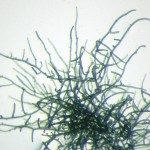Lien vers Pubmed [PMID] – 25404466
BMC Genomics 2014;15:977
BACKGROUND:
Cyanobacteria are an ancient lineage of photosynthetic bacteria from which hundreds of natural products have been described, including many notorious toxins but also potent natural products of interest to the pharmaceutical and biotechnological industries. Many of these compounds are the products of non-ribosomal peptide synthetase (NRPS) or polyketide synthase (PKS) pathways. However, current understanding of the diversification of these pathways is largely based on the chemical structure of the bioactive compounds, while the evolutionary forces driving their remarkable chemical diversity are poorly understood.
RESULTS:
We carried out a phylum-wide investigation of genetic diversification of the cyanobacterial NRPS and PKS pathways for the production of bioactive compounds. 452 NRPS and PKS gene clusters were identified from 89 cyanobacterial genomes, revealing a clear burst in late-branching lineages. Our genomic analysis further grouped the clusters into 286 highly diversified cluster families (CF) of pathways. Some CFs appeared vertically inherited, while others presented a more complex evolutionary history. Only a few horizontal gene transfers were evidenced amongst strongly conserved CFs in the phylum, while several others have undergone drastic gene shuffling events, which could result in the observed diversification of the pathways.
CONCLUSIONS:
Therefore, in addition to toxin production, several NRPS and PKS gene clusters are devoted to important cellular processes of these bacteria such as nitrogen fixation and iron uptake. The majority of the biosynthetic clusters identified here have unknown end products, highlighting the power of genome mining for the discovery of new natural products.




